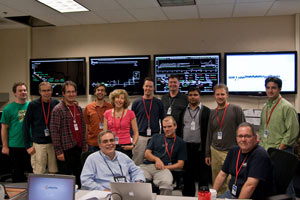
Handy Links
SLAC News Center
SLAC Today
- Subscribe
- Archives: Feb 2006-May 20, 2011
- Archives: May 23, 2011 and later
- Submit Feedback or Story Ideas
- About SLAC Today
SLAC News
Lab News
- Interactions
- Lightsources.org
- ILC NewsLine
- Int'l Science Grid This Week
- Fermilab Today
- Berkeley Lab News
- @brookhaven TODAY
- DOE Pulse
- CERN Courier
- DESY inForm
- US / LHC
SLAC Links
- Emergency
- Safety
- Policy Repository
- Site Entry Form

- Site Maps
- M & O Review
- Computing Status & Calendar
- SLAC Colloquium
- SLACspeak
- SLACspace
- SLAC Logo
- Café Menu
- Flea Market
- Web E-mail
- Marguerite Shuttle
- Discount Commuter Passes
-
Award Reporting Form
- SPIRES
- SciDoc
- Activity Groups
- Library
Stanford
Around the Bay
LCLS Users Test X-ray Laser's Effects on Atoms, Molecules Next
It's been a busy few weeks at the Linac Coherent Light Source. The Atomic, Molecular and Optical instrument's second user group, led by The Ohio State University physicist Louis DiMauro, wrapped up a five-day run early Tuesday morning, and the third group is set to start science today.
The first user group has provided the first experimental test of the LCLS beam, and has given researchers fresh insight into how the world's brightest X-ray laser interacts with matter.
"Right now we are very limited in our knowledge about the actual photon beam," DiMauro said. "No one has ever had access to this kind of light before. So, in terms of learning about the LCLS beam, these events could provide much needed diagnostics."
Working closely with AMO instrument scientists, DiMauro and his colleagues turned the LCLS beam onto a sample of neon gas, watching for something called two-photon ionization—an event where two photons converge to eject an electron from a single atom. Because two-photon ionization occurs extremely quickly, the process provides a sort of atomic stopwatch, giving researchers a better idea of the time scales the beam can resolve.
The experiment builds on work completed over the last two weeks, which put the LCLS beam on individual atoms for the first time—completely stripping neon atoms of electrons. DiMauro's work also sets the stage for next week's users, who will train the LCLS beam onto whole molecules. According to AMO instrument scientist John Bozek, the cumulative nature of the experiments is no accident.
"We're building complexity into the experiments as we go along," Bozek said. "It will help us understand how different types of matter respond to the incredible intensity of the LCLS and the short pulse nature that will let us do time-resolved work." This first run of user experiments at the AMO instrument will continue through mid-December.
After DiMauro's team finished their work this week, the LCLS staff took a scheduled break to complete maintenance work Tuesday and Wednesday. The third AMO experiment, led by Western Michigan University physicist Norah Berrah, will continue through next Tuesday morning.
—Nicholas Bock
SLAC Today, October 15, 2009
